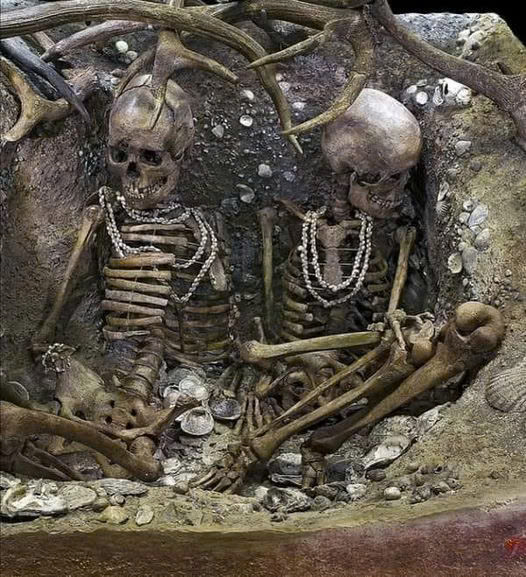In the rugged coastal landscapes of Brittany, France, an archaeological discovery unveiled a gripping tale of life, death, and mystery from 6,500 years ago. Between 1928 and 1934, renowned archaeologists Marthe and Saint-Just Péquart unearthed a burial site on Téviec Island that has since become one of the most compelling narratives of the Mesolithic era. Within this ancient grave lay the remains of two women, whose lives and deaths provide a haunting glimpse into a time long past. Their story is one of ritualistic burial, violent ends, and a community that thrived amidst the challenges of prehistoric life.

The discovery began with the meticulous excavation of a burial site that defied conventional expectations. The two women were interred in a manner that hinted at their importance within their community. Their grave was sheltered by a roof constructed from deer antlers, an unusual and significant element that immediately captured the attention of the archaeologists. Surrounding them was a remarkable assortment of grave goods, including necklaces, bracelets, and leg rings made from intricately arranged seashells. These artifacts not only reflected the craftsmanship of their era but also suggested that these women held a high status in their society.
In addition to the adornments, the grave contained an assortment of flint tools and animal bones, particularly from boars. These items painted a picture of a community that was both resourceful and deeply connected to its environment. The careful placement of these objects highlighted the ritualistic significance of the burial, indicating that the women’s deaths were not merely tragic events but moments of profound cultural and spiritual importance.
However, it was the forensic analysis of the remains that truly brought the story of the Ladies of Téviec to life. Researchers discovered evidence of severe injuries, raising questions about the circumstances of their deaths. One of the women bore multiple head wounds, and, most disturbingly, an arrowhead was found lodged between her eyes. These injuries were almost certainly fatal and pointed to a violent end. The trauma evident on their skeletons sparked intense debate among scholars and led to several theories about how and why they died.
One prevalent theory is that the women were victims of tribal conflict. During the Mesolithic period, competition for resources was fierce, and raids by rival groups were not uncommon. The possibility that they were attacked by another tribe seeking food, tools, or territory cannot be ruled out. Another theory posits that the women may have been ritually sacrificed. The Mesolithic era was marked by spiritual practices that sometimes involved offerings to deities or spirits, and their carefully adorned burial could suggest that their deaths had a ceremonial purpose. A third theory considers the harsh environmental conditions of the time. The Mesolithic period was a time of transition, with communities adapting to new challenges such as rising sea levels and changing ecosystems. It is possible that their deaths were a desperate response to the stress of survival in an increasingly difficult environment.
Beyond the mysteries surrounding their deaths, the remains of the Ladies of Téviec provide valuable insights into the lifestyle of their community. Analysis of their bones revealed a diet rich in seafood and meat, indicating that they lived in a society skilled in fishing, hunting, and perhaps even small-scale farming. This dietary evidence, combined with the grave goods and burial practices, paints a picture of a complex and resourceful community. It suggests a society that, despite the challenges of its time, managed to sustain itself and develop intricate social and cultural systems.
The legacy of the Ladies of Téviec extends far beyond their burial site. In 2012, their remains were displayed at the Toulouse Natural History Museum as part of an exhibition that captivated over 300,000 visitors. The exhibit transformed the archaeological findings into a vivid narrative that resonated with modern audiences, showcasing the universal themes of survival, conflict, and the human connection to ritual. It brought to life the realities of the Mesolithic period and demonstrated the power of archaeology to bridge the gap between the ancient past and the present.
The story of the Ladies of Téviec is more than an archaeological discovery; it is a reminder of the complexities of human history. Their grave, with its striking combination of violence and reverence, challenges us to consider the dualities of prehistoric life. On one hand, it reveals a society capable of great artistry and deep spiritual practices. On the other, it highlights the harsh realities of a world where survival often came at a great cost. These dualities invite us to reflect on the nature of humanity and the ways in which our ancestors navigated the challenges of their time.
As we delve into the lives of the Ladies of Téviec, we are reminded that the stories of our ancient ancestors are as multifaceted and profound as our own. Their tale is one of endurance, mystery, and the enduring human spirit. Through their grave, we glimpse a world that is at once alien and familiar, a world where beauty and brutality coexisted in the quest for survival. The Ladies of Téviec stand as a testament to the richness of human history and the power of archaeology to uncover the stories that connect us to our shared past.





